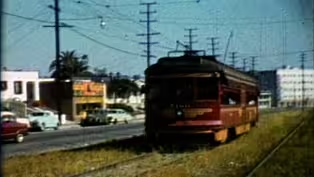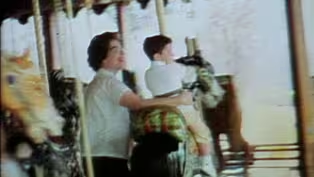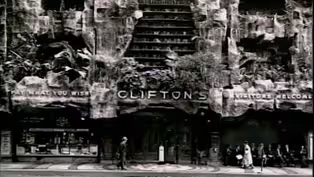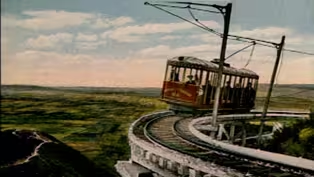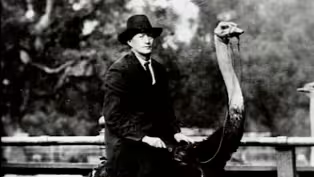
Pacific Ocean Park
Clip: Episode 1 | 4m 29sVideo has Closed Captions
Ocean Park was a popular L.A. amusement park in the early 1900s.
Between Venice Pier and Santa Monica Pier, Ocean Park was a popular L.A. amusement park in the early 1900s with theaters, roler rinks, dance halls, restaurants, rides, slides and more. In 1958 it became Pacific Ocean Park with an entry fee of $0.90.
Problems playing video? | Closed Captioning Feedback
Problems playing video? | Closed Captioning Feedback
Things That Aren't Here Anymore is a local public television program presented by PBS SoCal

Pacific Ocean Park
Clip: Episode 1 | 4m 29sVideo has Closed Captions
Between Venice Pier and Santa Monica Pier, Ocean Park was a popular L.A. amusement park in the early 1900s with theaters, roler rinks, dance halls, restaurants, rides, slides and more. In 1958 it became Pacific Ocean Park with an entry fee of $0.90.
Problems playing video? | Closed Captioning Feedback
How to Watch Things That Aren't Here Anymore
Things That Aren't Here Anymore is available to stream on pbs.org and the free PBS App, available on iPhone, Apple TV, Android TV, Android smartphones, Amazon Fire TV, Amazon Fire Tablet, Roku, Samsung Smart TV, and Vizio.
Providing Support for PBS.org
Learn Moreabout PBS online sponsorshipIf you wanted the big-time thrills, you had to head to the beach.
Chorus: ♪ By the sea, by the sea By the beautiful sea You and I, you and I Oh, how happy we'll be When each wave Comes a-rolling in We will duck or swim... ♪ Ralph: Once upon a time, everybody in Los Angeles wanted to go to the beach, and they did.
So, big wooden piers were built out into the Pacific, and little fun zones developed at the base of each one.
Chorus: ♪ I love to be beside Beside, beside the sea Beside the seaside... ♪ Ralph: Probably the most successful was Ocean Park between the Venice Pier and the Santa Monica Pier.
Chorus: ♪ You and I You and I... ♪ Barbara: Pacific Ocean Park began to be terribly popular about the late turn of the century, about... you know, 1918, 1917.
It was built before then, but that's when it hit its heyday.
Chorus: ♪ By the sea By the beautiful sea You and I, you and I Oh, how happy we'll be When each wave Comes a-rolling in We will duck or swim And we'll float and fool around The water over and under And then up for air... ♪ Barbara: It has theaters.
It had roller-skate rinks.
It had dance halls.
It had restaurants.
It had rides and slides and something for everybody.
Chorus: ♪ By the beautiful sea ♪ Ralph: But then, in 1958, a tidal wave of money rolled in, and it became Pacific Ocean Park, 28 acres of nautical nonsense which really rivaled Disneyland, and the all-day admission, just 90 cents.
J. Stanton: They took the old Highboy roller coaster and renamed it the Sea Serpent.
They took the old Stratoliner, which was this huge tower with rockets twirling around it, and renamed it Mr. Dolphin.
They rebuilt the entire end of the pier and turned it into a banana-boat train ride, where you went out into the jungle and then circled a volcano that was erupting and then crossed a rickety trestle to cross the tracks overlooking the ocean.
Jeffrey: They had a very scary ride that were, like, these little bubbles that actually went out over the ocean.
I remember, probably in 1964, '65, one of them fell into the ocean with a couple of people in there, and every time I'd ever ride on it, I'd go... "Is it gonna be me next?"
Colleen: I call it The Centrifuge.
I guess they call it The Whirlpool.
They got them in that-- It looks like a barrel with a bottom in it, and they started spinning, and pretty soon, you're glued to the back.
But my husband didn't realize that the floor dropped away also, and our kids, oh, they did get even with him.
He about died on that one.
[Music playing] Emcee: Another outstanding thrill at Pacific Oceans Park is when you ride over the Pacific Ocean in a bubble.
[Music playing] Ralph: They called it P.O.P.
for short, but not for long.
Nine years after it opened, business fell off, and the whole fantastic, fabulous foolishness just plain disappeared.
But we can still hear the squeals of the Sea Serpent and feel the salt spray of Mr. Dolphin and Mrs. Squid, and we'll be back with more "Things That Aren't Here Anymore."
[Music plays]
Before the Freeways, Los Angeles had The Red Car
Video has Closed Captions
Clip: Ep1 | 2m 22s | Before Los Angeles was known for cars, it was an innovator in rapid mass transit. (2m 22s)
Video has Closed Captions
Clip: Ep1 | 2m 3s | Before Beverly & La Cienega had the Beverly Center, it was home to Beverly Park. (2m 3s)
Early History of Clifton's Pacific Seas
Video has Closed Captions
Clip: Ep1 | 3m 28s | Clifton's, known for its generosity toward those who could not pay, was founded in 1930. (3m 28s)
Video has Closed Captions
Clip: Ep1 | 15m 15s | The Mount Lowe Railway opened on July 4, 1893. (15m 15s)
Ostrich Farms of Early Los Angeles
Video has Closed Captions
Clip: Ep1 | 1m 23s | Before the Great Depression, women's hats and ostrich feathers were in-fashion. (1m 23s)
Providing Support for PBS.org
Learn Moreabout PBS online sponsorshipSupport for PBS provided by:
Things That Aren't Here Anymore is a local public television program presented by PBS SoCal
